As Conservation Project Manager, Brenna Thompson has helped oversee several of Great Peninsula Conservancy’s recent land transactions. In this month’s blog post, she identifies how GPC’s conservation team identifies projects to acquire, including working with partners on large-scale projects, prioritizing climate-resilient lands, and expanding existing preserves. She also addresses a common question we receive from the community about protecting smaller parcels.
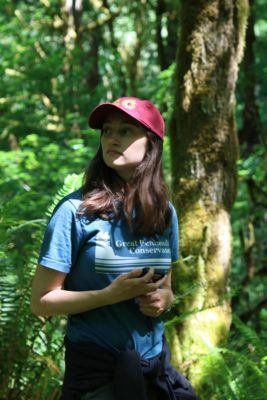
In a nutshell, how does GPC’s conservation team currently identify and prioritize projects? What role does parcel size play?
Acquiring land is hard, and managing it in perpetuity is even harder. It takes about the same amount of effort for GPC to acquire a one–acre property as it does to acquire a one hundred-acre property, and if our goal is to protect as much ecologically valuable land as possible then it is clear that large properties are where we need to focus most of our efforts.
GPC’s conservation team works to identify and prioritize projects firstly based on the conservation values found at the property. Large properties generally have more of the conservation values we most want to protect, including salmon streams, freshwater wetlands, pristine shoreline, estuary, and mature forest. Large properties also provide much better habitat for wildlife since they are likely to contain more of the resources wildlife need like food and shelter, and better protection from human sources of mortality such as roads and feral/domestic cats.
Secondly, we prioritize projects based on what is around them. Our goal is to preserve large blocks of land that can sustain wildlife and provide quality opportunities for passive recreation in nature. We therefore look to see if the project will help expand an existing protected area owned by GPC or some other organization like county parks or the Department of Natural Resources. If a small parcel is directly adjacent to an existing protected area, we will be much more interested in acquiring it.
GPC has heard from members in the community that we should protect more parcels that are smaller in size. We currently manage several preserves and easements less than 15 acres. What difficulties do we face in managing these properties?
When GPC takes ownership of a property or conservation easement, we commit to stewarding that property in perpetuity. GPC visits each and every property at least once per year and manages issues with dumping, vandalism, encroachment, hazard trees, and invasive species control. GPC currently has 60 preserves and easements on properties under 15 acres, most of which are scattered across our working region. The majority of these small preserves and easements were acquired in the 80s and 90s by the four regional land trusts prior to merging to create GPC. We are proud to help preserve these pocket greenspaces across our community, though many of them are in developed areas where issues with hazard trees and encroachment are much more acute.
Some of GPC’s smallest properties are ironically the most difficult to manage due to the fact that neighboring houses are so close. On these properties GPC needs to regularly remove hazard trees that we would normally leave to provide “snags” where birds can nest. These properties also cause the most issues with neighbors dumping yard waste and trash or planting invasive garden plants that then run wild on our property (e.g., butterfly bush, yellow archangel, and English ivy).
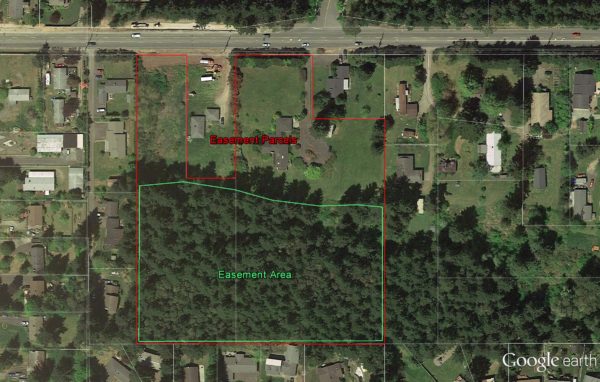
The combined acreage of these 60 small preserves and easements that are under 15 acres is nearly equal to GPC’s single largest nature preserve – the 280-acre Grovers Creek Preserve. It takes 60 times the staff time and resources to manage these many small properties as it does to manage Grovers Creek Preserve. Our goal is to responsibly manage each and every property under our ownership in perpetuity, which is why our focus is on protecting a small number of large properties.
What would be some good reasons to purchase a smaller parcel?
Many land trusts refuse to ever acquire a property that is smaller than a certain designated acreage threshold, but GPC considers each project on a case-by-case basis. Over the last ten years GPC has acquired 12 small properties that are each under 15 acres, and we will likely continue to acquire a select number of small properties in cases where the conservation or recreation values are especially significant.
GPC’s McLane Cove Preserve, for example, is only 2.5 acres but contains 1,200 feet of shoreline on an important pocket estuary in Mason County. In this case the conservation values were exceptional enough that it was worth the considerable effort involved in securing grant funding to purchase this property, and the even greater effort of stewarding this property in perpetuity.
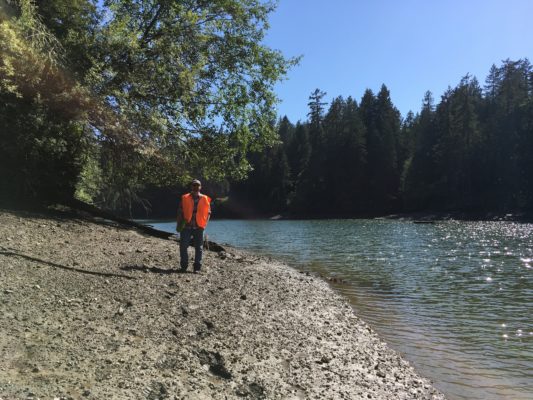
One of our conservation priorities is to expand current preserves by purchasing adjacent parcels, regardless of size. Why is this a priority?
Once GPC invests in a particular area by creating a nature preserve or acquiring a conservation easement we want to make that protected area as large as possible by also preserving adjacent undeveloped parcels. The Kitsap Peninsula is experiencing rapid development, and we know that when the opportunity presents itself to purchase land directly adjacent to land we already own we cannot afford to let it slip away. In these cases, even small parcels become a priority, particularly when they contain habitat like shoreline, salmon streams, or wetlands.
In north Kitsap County’s Miller Bay, for example, GPC is piecing together a chain of small shoreline properties that together protect a significant portion of the upper estuary. GPC is currently working to acquire a 1.5-acre piece of shoreline here, which would not normally be a priority as a stand-alone property. In this case its close proximity to land GPC already owns (and its exceptional coastal wetland) makes it important to acquire.
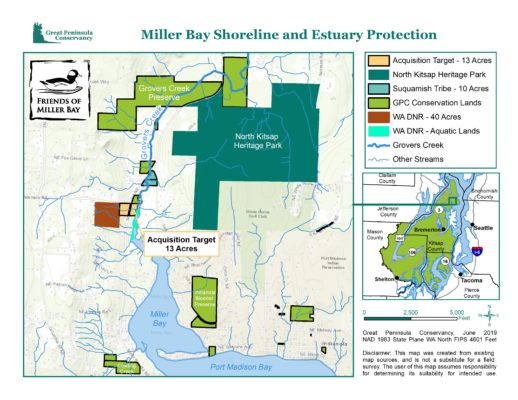
GPC has started to prioritize the acquisition of “climate-resilient lands.” What does this mean and how does parcel size matter when identifying these projects?
Climate change is expected to impact GPC’s working region through sea level rise, drier more drought-stricken summers, and rainier winters that can exacerbate flooding. With this in mind, GPC aims to acquire climate-resilient land that is most likely to sustain its important conservation values in the face of these projected changes. This means prioritizing coastal properties with enough elevation range that they will not be completely underwater in 100 or 200 years. It also means prioritizing stream corridors and freshwater wetlands that can help reduce flooding and trap runoff in the winter. During the dry summer, this runoff is slowly released to sustain wildlife like salmon as well as provide aquifer recharge and drinking water for people.
Climate change will play out on a landscape level, and over time we will likely see more southern species migrating north. Large properties can provide important links in wildlife corridors that enable species to safely migrate through an increasingly developed landscape. Climate change will also play out on the micro-site level, with tree species that once survived on dry south facing slopes now only surviving on wetter north facing slopes or ravines. Large properties have more micro-climates created by topographic features that enable plants and animals to adapt to climate change without migrating.
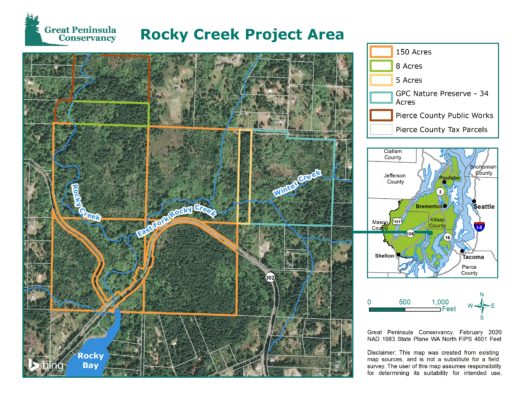
(You can read more about one of GPC’s climate-resilient projects in our last blog post.)
How does GPC work with partners to protect large areas of contiguous conserved lands?
Some of GPC’s greatest successes in protecting large areas of contiguous conserved lands have involved working with partners. The Kitsap Forest and Bay Partnership, for example, was a community-wide effort in which dozens of government agencies, tribes, non-profit organizations, and community groups joined together to protect over 4,000 acres in northern Kitsap County. This decade-long partnership helped to protect the 3,400-acre Port Gamble Forest Heritage Park, the 370–acre North Kitsap Heritage Park expansion, and GPC’s 280-acre Grovers Creek Preserve. These properties help form a chain of nearly contiguous protected lands in northern Kitsap County, which will provide exceptional recreational opportunities and wildlife habitat for generations to come.
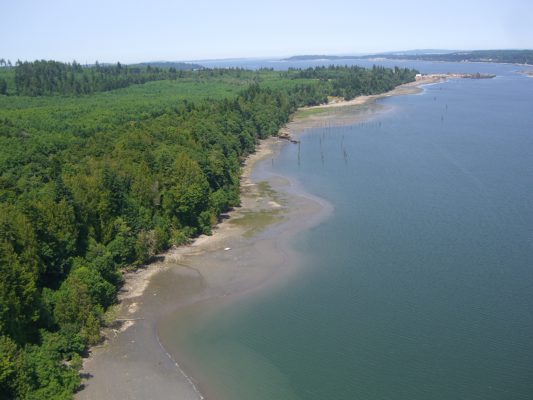
What other resources exist for landowners or community members interested in protecting land that GPC cannot currently prioritize?
Tax designations for open space and forest resources provide a way for landowners to protect land that GPC cannot currently prioritize, while also reducing the tax burden of these properties. Kitsap County and Pierce County also have nascent Transfer of Development Right Programs, in which landowners in rural areas can sell their development rights to developers in urban areas through a marketplace.
